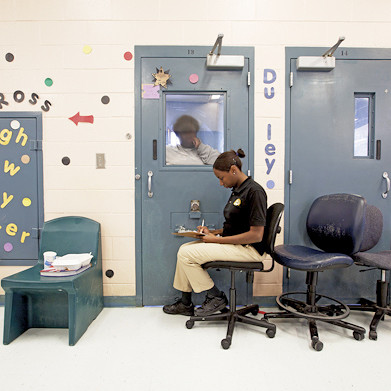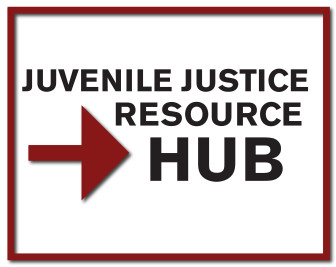
Photos by Richard Ross
A 15-year-old girl on suicide watch, under constant surveillance. Macon Youth Development Campus, Macon, Georgia.
JONESBORO, Georgia — Leandra Phommavongsay began his speech to the dozen or so teenagers gathered in the back of a Clayton County courtroom by recounting his recent travels.
He had been to California, and before that to Florida and to Texas, all places he hadn’t ever expected to go when he was growing up in small-town Georgia, south of Atlanta.
“I just came from San Francisco. I’m not sure you’ve ever seen San Francisco. But San Francisco is beautiful,” he said.
He had once been like them, Phommavongsay, now 21, told the teens sitting in two rows, a few parents scattered among them. He hung out with the wrong crowd, and got into trouble with the cops for petty, and sometimes not so petty, offenses.
They could go to San Francisco, too, the way he had for a job detailing cars. But only if they made the right choices during their time in the Second Chance Court program, a community-based diversion program that seeks to keep teenagers out of long-term lockup.
“Grow, man. Think, man. Forget the weed. Forget those bums on the block,” he said.
He grinned at them. “Go to Miami and get crazy on the beach.”
Phommavongsay landed in Second Chance five years ago after charges that included robbery and aggravated assault. The program has a long list of requirements, including strict GPS monitoring, regular school attendance, participation in programs such as drug treatment or family therapy and meetings with court officials.
He completed the Second Chance program, went to cosmetology school and works in a print shop. He thinks he would like to open his own business someday.
Without the program, he says his life would look much different: “I’d be dead or in prison.”
Second Chance Court is the kind of program counties across Georgia have deployed as part of an ongoing juvenile justice reform effort than began in 2013. Like states across the country, Georgia wants to keep teens out of prison and in their communities, with better outcomes for families, public safety and the state’s bottom line.
The Republican-controlled Georgia Legislature passed the reforms unanimously in 2013, shortly after making major changes to the criminal justice system. Republican Gov. Nathan Deal, a former juvenile court judge, has championed the changes.
The Georgia reforms, rooted in an overhaul of the juvenile justice code, included a move away from locking up status offenders and the creation of a statewide database of juvenile justice referrals and results. The state also launched the Juvenile Justice Incentive Grants program to fund evidence-based programs in the counties that take their cues from programs like Second Chance Court.
Since 2013, the number of youth in secure confinement has dropped by 17 percent and youth awaiting placement has decreased by 51 percent.
Georgia’s reforms hit many of the marks for reforms rooted in evidence about what works, said Mark Lipsey, director of the Peabody Research Institute at Vanderbilt University. Lipsey has helped the state, and many others, evaluate how well programs are working.
Lipsey pointed to the state’s decision to make the reforms in the statute, emphasize evidence-based practices and assemble strong leadership teams as signs of a very strong effort.
“I think what’s going on there is very much state of the art and quite remarkable,” he said.
Budget proposal
When lawmakers were considering the reforms three years ago, researchers at the Pew Charitable Trust said the state could save $85 million during the next five years, largely from avoiding the costs of building two new secure facilities.
Now, as the number of youth in detention facilities come down, the state has the potential to take money they would have spent on running the facilities and put the funding into additional community programming, said Joe Vignati, deputy commissioner of the Georgia Department of Juvenile Justice.
The latest budget proposal from Gov. Deal calls for closing one long-term  youth detention facility and moving more than $5 million into community-based alternatives. For example, the budget proposal includes $2.7 million for 40 “step-down” slots that help move kids from secure detention to residential facilities.
youth detention facility and moving more than $5 million into community-based alternatives. For example, the budget proposal includes $2.7 million for 40 “step-down” slots that help move kids from secure detention to residential facilities.
The code overhaul is what allowed for the slots, but the money wasn’t there in the first few years for the department to make use of them. Now they can as the savings from reform become tangible.
“We’re basically taking all those funds and moving them from secure facilities into the communities. That’s a big shift,” Vignati said.
The costs of long-term and short-term lock-up still make up more than 60 percent of the state Department of Juvenile Justice’s budget, but the costs are growing more slowly than community services in the governor’s most recent proposal.

Metro Regional Youth Detention Center, Atlanta.
From fiscal year 2014 to the fiscal year 2017 proposal, funding for community services grew 17 percent, from $82 million to $95 million in a budget of $334 million. Meanwhile, funding for secure commitment grew 11 percent, from $85 million to $95 million and secure detention grew 12 percent from $107 million to $120 million.
Vignati said the costs of long-term and short-term confinement should continue to come down — and the savings redirected to community programs — as the state gets a handle on just how low the number of juvenile offenders they house can go.
But even as fewer beds are used, the costs of running the existing facilities won’t go away. They require staffing, heating and maintenance. Additional costs also could come from the need to update facilities built decades ago and to ensure they’re equipped to handle the highest-risk teenagers, who aren’t placed in community services, said Vignati.
“We’re going to get tougher kids, they’re going to be more resistant to treatment so it requires more intensive services,” he said.
The state also has steadily increased the amount of funding dedicated to Juvenile Justice Incentive Grants program, from $6 million in the fiscal year 2014 budget to $8.8 million in fiscal year 2016. In the participating counties, 1,666 youth had
access to evidence-based programming in the second year of the program, up from 1,122 in the first. The programs all are ranked “effective” or “promising” on a federal registry to reduce criminogenic behaviors in juveniles and the counties have chosen programs rooted in individual, family or group therapy.
Overall, the counties saw out-of-home placements drop 54 percent in fiscal year 2015, compared with a 2012 baseline.
Steve Teske, the Clayton County juvenile judge who started Second Chance Court and has helped lead the charge for reform statewide, said the grants have been instrumental in his county.
The Second Chance program already was underway and showing significant decreases in secure commitment when the incentive program began.
However, the grant allowed the county to target the needs of youth who still were being committed, often for family dysfunction, Teske said. During fiscal year 2015, out-of-home placements dropped 63 percent in the county.
Mark Ferrante, a senior policy analyst at the Council on State Government’s Justice Center, said Georgia also has been aggressive about pursuing federal funding to support its work.
“They’re very thoughtful and proactive about applying for grants,” he said.
Next wave of reforms
As Georgia enters its third year of reforms, Vignati said the state has shown how to be smarter and more creative about juvenile justice. The key now is to build on the state’s progress.
“We have to keep our eye on what we set out to do and measure the changes and adjust the course as needed,” he said.
The Georgia Council on Criminal Justice Reform, which is charged with making recommendations to improve both the criminal and juvenile justice systems, called for the next wave of juvenile reforms to focus on schools in its latest annual report.
Schools are one of the largest sources of referrals for the juvenile justice system. The proposed reforms aim to clarify the roles of schools and law enforcement on campuses.
A student who shouts a swear word should be disciplined at school, not accused of disorderly conduct and sent to the juvenile justice system, said Teske, who is a member of the council. Similarly, a schoolyard fight shouldn’t automatically bring assault charges.
“The overall objective is to stop criminalizing kids for what is typical adolescent behavior,” he said.
The report recommended that schools be required to develop and use a system of progressive discipline before a juvenile complaint is filed and that school systems enter into model agreements with law enforcement that clearly delineate how student behaviors will be addressed. The council also recommended measures to improve the procedural fairness of school disciplinary proceedings.
The report also calls for the state to restrict secure detention for anyone age 13 or younger, unless they are charged with a serious crime such as murder. Since the reform, the state has seen a spike in the number of younger children held in secure detention.
“By expanding the detention of younger children and exposing such youth to the trauma correlated with detention, Georgia, is, in effect, voiding the beneficial effects of juvenile reform for this most vulnerable population,” the council said.
The reason the for the spike is because reforms that direct juveniles into community-based programs largely have affected teenagers ages 15 and older, who more likely to commit serious crimes than younger children. That has created a vacuum that has unintentionally sucked younger children into the system, said Melissa Carter, executive director of the Barton Child Law & Policy Center at the Emory University School of Law.
Carter said the state’s commitment to reform means that each round of policy recommendations can jump-start valuable conversations about what should happen next.
For example, a discussion of how the youngest adolescents in Georgia should be treated in the justice system could re-energize a debate about whether to raise the age for when teenagers are automatically treated as adults. Georgia is one of only a few states that treats teenagers as adults beginning at age 17, rather than 18.
Or, when policymakers consider the importance of restoring youth to their communities, it can prompt ideas about how to reintegrate youth who are serving long sentences, Carter said.
“I feel like we’re on solid footing. With every step forward, we start thinking about the next step,” she said.
Phommavongsay said he’s confident he can move forward as well.
He still makes mistakes, the kinds of regular growing-up moments he says feel like bumping his head, but he’s stayed out of trouble — a fact he credits in large part to Second Chance. He intends to keep it that way.
“I’ve come too far. I’ve learned too much,” he said.
I had previously read Judge Steven Teske’s 12/8/2015 JJIE article “States Should Mandate School-justice Partnership to End Violence Against Our Children”. I didn’t realize how much progress was actually taking place in Georgia, already. The cost savings in the state’s budget is a great selling point for other states considering this. I’m glad the Pew Research data was included in this article. I believe reference to Judge Teske’s endeavors in Connecticut would have complemented this article, in spite of it’s focus on just Georgia. The capital expenditure of building two additional prisons versus the greater long-term savings of this approach, may give investors in the Private For-Profit Prison business, pause to reflect on their investment decisions.